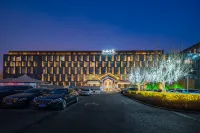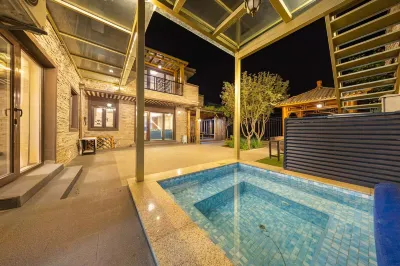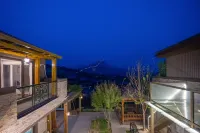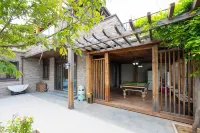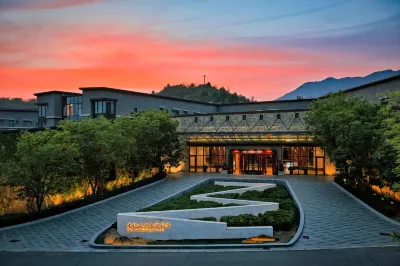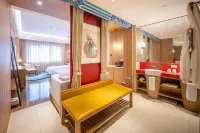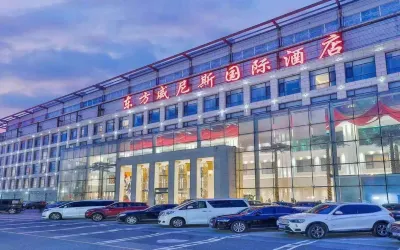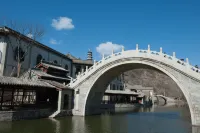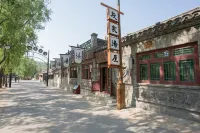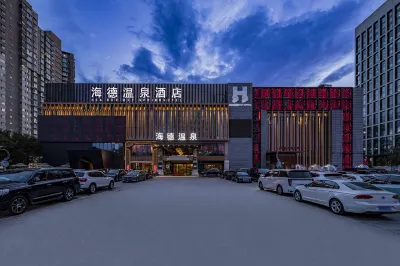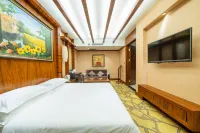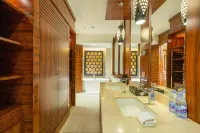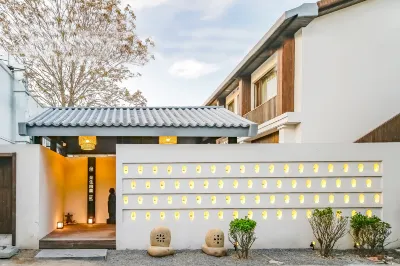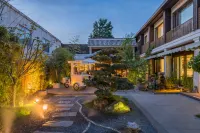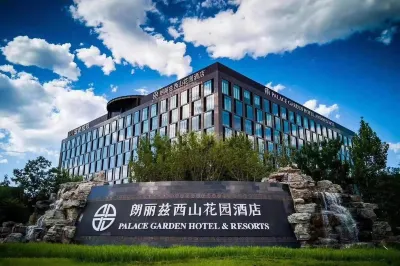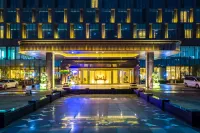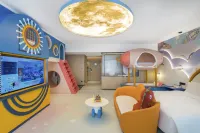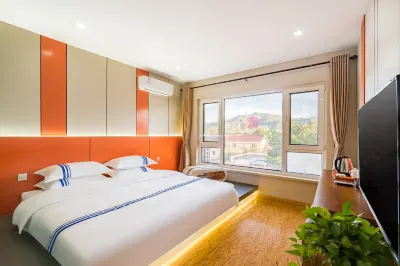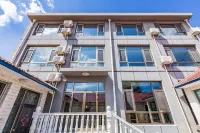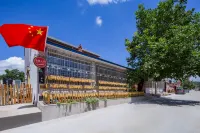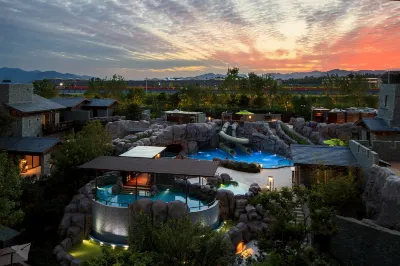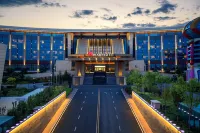
ينابيع ساخنة Hotels in بكين, الصين
أدخل تواريخ سفرك للتحقق من أحدث الأسعار والتوافر
اسحب للأسفل لعرض المزيد
التصفية حسب:
تصنيف النجوم الخاص بالفندق
≤2345
تقييم النزلاء
رائع 9+ممتاز 8+جيد 7+لطيف 6+Top ينابيع ساخنة Hotels - بكين
Choose your travel dates to see the latest prices
الأكثر رواجًا
أقل سعر
الأقرب إلى وسط المدينة
الأفضل تقييمًا
فنادق في بكين
Xishan Hot Spring Hotel is located in the northwest of Haidian. The hot spring water comes from the rich mineral hot springs 3,000 meters below the Xishan Mountains. It is a leisure resort that packages hot springs, accommodation, dining, health care and entertainment together to bring everyone a perfect holiday experience with the concept of "happiness, fashion and health".
متميز
4154 تقييمًا
9.4/10
السعر ابتداءً من
CAD 114
في الليلة
فنادق في بكين 4.8% من الزوار يختارون هذه المنطقة
The Gubei Water Town · Outdoor Private Hot Spring · Cuilu Mountain Residence Party Villa is an ideal spot for travelers wanting to discover the city. The Gubei Water Town · Outdoor Private Hot Spring · Cuilu Mountain Residence Party Villa offers a pleasant stay in Beijing for those traveling for business or leisure. In terms of transportation, Gubeikou Railway Station is approximately 15km away. Gubeikou Railway Station is the closest option for those who prefer to travel by train, approximately 15km away. With multiple attractions nearby including Zhen Yuan Escort Agency, Ba Qi Hall and BEIJING W TOWN, guests will find plenty to keep themselves occupied. In their spare time, guests can explore the hotel's surroundings. Guests of this Beijing hotel can make use of the parking facilities.
85 تقييمًا
8.6/10
السعر ابتداءً من
CAD 38
في الليلة
فنادق في بكين 4.8% من الزوار يختارون هذه المنطقة
Beijing Wtown Resort is located at the core of Gubei Water Town Resort, adjacent to Sun Moon Island Square. Adjacent to the music and water dance show and UAV performance square, near the snack street, the hotel has its own bathing pool area, which allows guests to enjoy the leisure of Beijing Wtown Resort. The online celebrity infinity swimming pool in the hotel is a holy place for the hotel to take photos and punch cards.
This is a large-scale themed resort hotel in Beijing Wtown Resort, equipped with overall hardware facilities and equipment according to star standards.
The hotel has a variety of Chinese and Western restaurants with distinct styles, as well as unique dining rooms where guests can taste delicious dishes from all over the country; At the same time, it has a top-notch conference center and banquet hall, as well as a VIP reception hall with complete facilities and equipment. It also has a modern digital conference indicator system, projection system, and advanced lighting and sound equipment. With a well-trained professional conference team, it ensures the perfect quality of the conference and customizes various banquet and conference types for guests to meet all the needs of high-end conferences.
The hotel is equipped with a health club that integrates fitness, wellness, leisure and entertainment, as well as business and social activities. Comfortable and elegant environment, high-end and complete facilities, meticulous service, allow guests to experience a new modern concept of health and wellness and a luxurious experience exclusive to members.
ممتاز
4601 تقييمًا
9.6/10
السعر ابتداءً من
CAD 184
في الليلة
فنادق في بكين 16.1% من الزوار يختارون هذه المنطقة
The Venice Oriental Hotel Beijing Lize Business District provides a great place for travelers to relax after a busy day. The Venice Oriental Hotel Beijing Lize Business District is an ideal choice for travelers who want to take in the sights and sounds of Beijing. With Beijing West Railway Station just 5km away and Beijing Capital International Airport only 41km away, transportation is very convenient. Transportation around the city is also convenient, with Xiju Metro Station within walking distance. The nearby area boasts an abundance of attractions including Shuting 24-Hour Study Room, Bolele Children Theme Amusement Park and The Military Museum of Chinese People's Revolution. After a long day of sightseeing, guests can retire to the comfort of the hotel. For those driving themselves, parking is provided on site. This hotel is a popular accommodation for guests traveling for business.
860 تقييمًا
8.6/10
السعر ابتداءً من
CAD 47
في الليلة
فنادق في بكين 4.8% من الزوار يختارون هذه المنطقة
The Duan’s Quadrangle Inn is an ideal spot for travelers wanting to discover the city. Visitors to Beijing will find that the Duan’s Quadrangle Inn is a fantastic accommodation choice. The hotel is approximately 16km away from Gubeikou Railway Station. The nearest railway station is Gubeikou Railway Station, approximately 16km away. This hotel is located near many of Beijing's attractions including Great Wall At Simatai, Ba Qi Hall and Dragon and Phoenix Pool. When guests have some time on their hands they can make use of the onsite facilities. This Beijing hotel provides parking on site. Our guests rate this hotel as one of the best hotels for cleanliness. This hotel is a popular accommodation for guests traveling with families.
متميز
233 تقييمًا
9.5/10
السعر ابتداءً من
CAD 114
في الليلة
فنادق في بكين 5.8% من الزوار يختارون هذه المنطقة
The Header Hot Spring Hotel (Haide Wenquan Jiudian) is located a 15-minute drive from Chaoyang Park and a 30-minute drive from Beijing Capital International Airport. A number of restaurants and shopping centers are within walking distance of the property. Diners can choose from a buffet spread of food from around the world or sample Cantonese dishes at the on-site Chinese restaurant. Business travelers can make use of conference rooms and a banquet hall to host meetings and events. Guests can enjoy free parking and WiFi access in public areas.Guests at this five-star Beijing hotel can relax in one of hot spring pools, enjoy a massage or make use of the fitness center and indoor swimming pool.
943 تقييمًا
8.9/10
السعر ابتداءً من
CAD 85
في الليلة
فنادق في بكين
Beijing Dazhu Youlan Hotel is located in Bensi Hutong, Dongcheng District, surrounded by Wangfujing and Tiananmen, with convenient shopping and transportation.The hotel is themed on orchids, and the names of the guest rooms are all derived from ancient orchid poems. To meet the comfort of modern people, each room is equipped with a hot spring pool, a full set of tea sets and floor heating throughout the room.The courtyard is surrounded by water and rocks, and the flowers are fragrant. The courtyard has both Thai charm and Chinese simplicity. Living in a century-old alley, staying in the "Orchid" courtyard, watching flowers and listening to the rain, is comfortable and leisurely.
ممتاز
1763 تقييمًا
9.7/10
السعر ابتداءً من
CAD 131
في الليلة
فنادق في بكين
The Palace Garden Hotel (Langlizi Xishan Huayuan Jiudian) is located approximately 38 km (24 mi) from Beijing Capital International Airport.Diners enjoy Chinese food at the hotel restaurant. In their spare time, guests can unwind with a drink in the bar. Recreational facilities include a gym and an indoor swimming pool. Those wanting to relax can make use of the hot spring. This Beijing hotel provides Wi-Fi in public areas as well as parking on site.
ممتاز
2217 تقييمًا
9.6/10
السعر ابتداءً من
CAD 152
في الليلة
فنادق في بكين
Badaling Inn Beijing is located in Dongcaoying Folk Tourism Village, Badaling Town, surrounded by mountains. It is adjacent to the Badaling Great Wall, a world cultural heritage site, and neighbors the 500-year-old Chadong Ancient City. Nearby attractions also include Badaling Wildlife Park, Red Leaf Ridge, the Ancient Great Wall, Badaling National Forest Park, the 2019 Beijing World Horticultural Expo, and various natural landscapes.
The inn features an overall traditional Chinese courtyard (siheyuan) style, which is 古朴 yet modern. It is equipped with advanced facilities, including heating and air conditioning, independent bathrooms in each room with 24-hour hot water, a full set of free daily necessities, and full Wi-Fi coverage. Here, you can fully experience the old Beijing culture, making it a boutique inn for traveling to Badaling.
Since its opening, it has been widely praised by celebrities in the entertainment industry and countless domestic and foreign tourists. It has been awarded the title of "Beijing Rural Tourism Folk Household" by the Culture and Tourism Bureau of Yanqing District, Beijing.
ممتاز
318 تقييمًا
9.6/10
السعر ابتداءً من
CAD 26
في الليلة
فنادق في بكين
The Beijing Marriott Hotel Changping is an ideal spot for travelers wanting to discover the city. Visitors to Beijing will find that the Beijing Marriott Hotel Changping is a fantastic accommodation choice. Boasting a convenient location, the hotel is just 6km from Changping North Railway Station and 50km from Beijing Capital International Airport. Being just minutes away from Changping Xishankou Metro Station allows guests to explore the city with ease. With multiple attractions nearby including Beijing Marriott Hotel Changping Tanglegong Hot Spring, Ledo Port Ferris Wheel and Great Red Gate, guests will find plenty to keep themselves occupied. In their spare time, guests can explore the hotel's surroundings. Guests of this Beijing hotel can make use of the parking facilities. If cleanliness is important to you, this hotel makes an excellent choice, as our guests consider this to be one of the cleanest hotels in the city. For guests traveling with families, this hotel is consistently one of the most popular choices.
جيد
2824 تقييمًا
9.1/10
السعر ابتداءً من
CAD 138
في الليلة
الأسئلة الشائعة
كيف يمكنني إجراء حجز فندق على Trip.com؟
لحجز فندق على موقع Trip.com، ما عليك سوى تحديد وجهتك وتواريخ السفر وعدد النزلاء على الصفحة. ثم تصفح الفنادق المتاحة واختر الفندق الذي تريد حجزه. اتبع الخطوات لإدخال معلومات الدفع الخاصة بك وإكمال الحجز.
كيف يمكنني الحصول على فنادق بأسعار منخفضة على Trip.com؟
هناك طرق عديدة للحصول على فنادق بأسعار
مناسبة على موقع Trip.com. يمكنك تضييق نطاق نتائج البحث عن طريق تصفية الفنادق وفقًا لنطاق السعر المفضل لديك، او يمكنك فرز النتائج حسب السعر لعرض الخيارات الأقل تكلفة أولاً.
أين يمكنني العثور على عروض الفنادق على Trip.com؟
كيف يمكنني الحصول على أسعار أقل للفنادق؟
في بعض الأحيان يكون حجز الفنادق في منتصف الأسبوع أرخص، ولكنه يعتمد أيضًا على الموسم.
كم عدد الفنادق المتوفرة على Trip.com؟
يمكنك العثور على أكثر من 1.5 مليون فندق في أكثر من 230 دولة أو منطقة على Trip.com. لم تقرر أي فندق تحجزه بعد؟ تصفح موقعنا للحصول على أفكار!
هل بإمكاني إلغاء أو تغيير حجز الفندق عبر Trip.com؟
يعتمد ذلك على سياسة الفندق وتاريخ الإلغاء. يرجى مراجعة قسم السياسة في صفحات الفندق ذات الصلة. لإلغاء حجوزاتك او تغييرها، قم بتسجيل الدخول إلى حساب Trip.com الخاص بك، وانتقل إلى "حجوزاتي"، واتبع التعليمات.
كيف يمكنني التواصل مع خدمة دعم عملاء Trip.com؟
يمكنك التواصل مع خدمة دعم عملاء Trip.com على مدار 24 ساعة طوال أيام الأسبوع من خلال زيارة مركز المساعدة على Trip.com وإرسال طلب. يمكنك أيضًا التواصل معنا عبر الهاتف او خدمة الدردشة، حسب موقعك.
معلومات السفر المحلية
| عدد الفنادق | 304 |
|---|---|
| عدد التقييمات | 64,395 |
| السعر في أيام الأسبوع | CAD 506 |
| متوسط سعر الويكند | CAD 584 |

